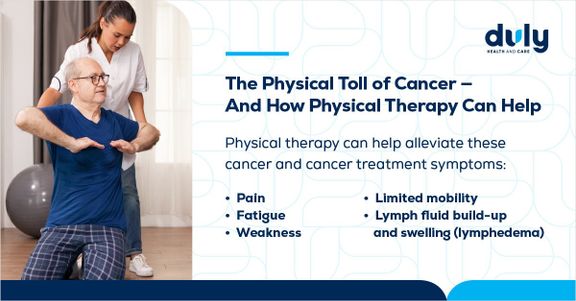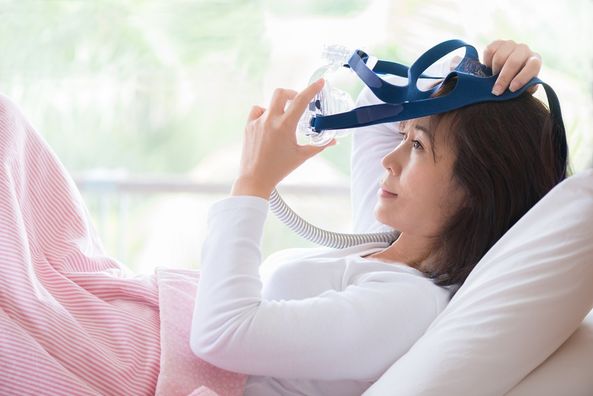Cancer and cancer treatment take an incredible toll on your body. As you recover from cancer, you might face a number of physical challenges, including reduced strength, fatigue, pain, and trouble getting around.
But your body has an impressive ability to recover and regain some of its lost abilities, especially with the right support. With physical and/or occupational therapy for cancer rehabilitation, you can ease pain, improve strength and mobility, and feel energized once again.
Here’s how physical/occupational therapy can help with cancer rehabilitation, and when you should seek support.
How Cancer and Cancer Treatment Affect Your Body
In the past decade, cancer treatment has improved greatly. From more targeted approaches to new therapies, there are now more options than ever to help your body combat this disease.
Still, cancer and its treatment can lead to physical side effects. While treatment destroys cancer cells, it can also damage healthy cells in the process. The disease itself can take a toll on your body. Other reasons for side effects include surgery, radiation, chemotherapy, and other medications.

Cancer treatment remains life-saving, and the risk of side effects is well worth it. However, these side effects can still be uncomfortable and impact your day-to-day life. They may even make it so you don’t want to continue cancer treatment.
To prevent and manage these side effects, many people turn to physical or occupational therapy for cancer rehabilitation.
How Therapy Aids in Cancer Rehabilitation
Lots of people think of therapy as a way to address pain or injuries from sports or accidents. But physical and occupational therapists are trained to help you find relief from pain and discomfort in your daily life no matter the cause, including cancer.
Physical and occupational therapists are equipped to help you recover from cancer in a range of ways. Through education and exercise, physical/occupational therapy helps you work toward your goals both during sessions and at home to reduce the side effects of cancer and its treatment.
If you’re experiencing side effects from cancer and cancer treatment, make an appointment with a Duly physical or occupational therapist to support your cancer rehabilitation and recovery.
Build Strength
Muscle weakness and muscle loss are common side effects of cancer and cancer treatment. They impact up to 80% of people with advanced cancer and can lead to trouble with daily tasks (such as getting out of bed and taking a bath), reduced independence, and mental health struggles.
Physical/occupational therapy is a key approach to building strength during and after cancer. You’ll focus on strength and endurance exercises that are aligned with your goals, whether that means being able to walk your dog, pick up your grandchildren, or move around your house with ease.
Regain Motion
Walking is a crucial part of daily life, but cancer survivors are over 20% more likely to have problems with mobility. This might mean walking slowly or having limitations in getting around, both of which can severely restrict your daily life.
Physical therapy helps you regain your ability to move, such as walking and climbing stairs. Using exercises that promote strength and learning how to adapt your movements, you’ll be able to go about your day safely and with fewer limitations.
Battle Fatigue
Cancer-related fatigue (CRF) is more than just feeling tired. It’s a persistent form of exhaustion that can lead to not wanting to engage in activities, being too tired to eat, and limiting your daily life.
CRF impacts up to 80% of cancer survivors, and it can occur during treatment or remission. To address CRF, physical therapists work with you on endurance training alongside strength training. This combination fights fatigue and gives you the energy for daily activities.
Ease Pain
Cancer pain can be a result of a number of factors, including surgery, treatments, tests, and the disease itself. Pain can be ongoing and impact your job, relationships, ability to sleep, and appetite.
Physical/occupational therapists help identify the source of pain and treat it accordingly. This might include simple exercises or assistive devices, like splints or braces.
Reduce Swelling
Lymphedema, which is a buildup of fluid in soft tissue, can occur as a side effect from cancer treatment. It can be uncomfortable and lead to secondary complications including recurrent infections and skin breakdown. Over time, lymphedema can impact mobility and make it harder to function with the affected area. Specialists that treat lymphedema can assist with management of the swelling through massage, compression, and exercises to promote lymphatic drainage.
When to Use Physical Therapy for Cancer Rehabilitation
If pain, discomfort, or limitations from cancer treatment are impacting your daily life, it may be time to address these concerns with physical/occupational therapy.
It’s important to get support as soon as possible before side effects become worse. For instance, if joint stiffness in your arm keeps you from reaching overhead, you might stop using your arm as frequently. In turn, this might cause your arm to become stiffer and weaker in the long run.
Physical/occupational therapy is designed to improve your strength and mobility no matter the cause. When it comes to cancer and its treatment, physical/occupational therapy manages its side effects and helps you regain independence, reduce pain, and enjoy daily activities once again.
Health Topics:








